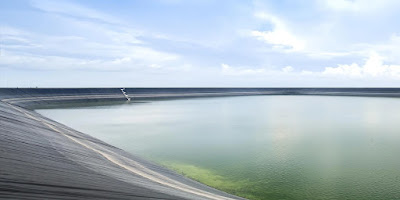Water scarcity and management have long been critical in India,
which depends heavily on seasonal monsoons for its water supply. Traditional
water storage systems often struggle to meet the growing demand for efficient
water conservation. However, introducing rubber dam in India is revolutionising
how water is stored, controlled, and utilised. These innovative structures
offer a flexible, cost-effective, and sustainable solution to India’s water
management challenges.
What is a Rubber Dam?
A rubber dam is an inflatable, flexible dam constructed using high-strength
rubber material. These dams can be installed across rivers, streams, and canals
to regulate water flow, store water for irrigation, and prevent flooding.
Unlike conventional concrete dams, rubber dams are highly adaptable and can be
inflated or deflated as per the water requirement.
Types of Rubber Dams
There are various Rubber dam types depending on their
construction, material, and method of inflation:
- Air-Inflated
Rubber Dams – These are filled with air to
create a flexible barrier. They are lightweight, easy to install, and
ideal for short-term water control applications.
- Water-Inflated Rubber Dams
– Instead of air, these dams use water for inflation, making them more
stable and resistant to external environmental factors.
- Combination Rubber Dams
– A hybrid of air and water inflation, these dams provide a balance of
flexibility and durability.
- Fabric-Reinforced Rubber Dams
– These are made with reinforced synthetic materials to enhance durability
and withstand extreme weather conditions.
Rubber Dam Construction
and Installation
Rubber
dam construction involves several key
steps to ensure stability and efficiency:
- Site
Selection – Engineers analyze the river
or canal's flow characteristics to determine the best location for the
dam.
- Foundation Preparation
– A concrete foundation is laid to anchor the rubber dam securely.
- Installation of Rubber Bladder
– The rubber dam is attached to the foundation using a secure anchoring
system.
- Inflation System Setup
– Depending on the type of rubber dam, air or water inflation systems are
installed.
- Testing and Monitoring
– The dam is tested for leakage, pressure stability, and structural
integrity before full operation.
Advantages of Rubber
Dams
The adoption of rubber dams in India has provided several
benefits, making them a preferred choice over traditional dams:
- Cost-Effective
– Rubber dams are significantly more affordable to construct and maintain
than conventional concrete dams.
- Adaptability
– These dams can be inflated or deflated based on water needs, making them
highly efficient in water management.
- Eco-Friendly
– Unlike concrete structures, rubber dams do not disrupt natural
ecosystems and can be installed with minimal environmental impact.
- Easy Maintenance
– Rubber dams require minimal upkeep, and any necessary repairs can be
completed quickly.
- Flood Prevention
– By controlling water flow, rubber dams help prevent floods during heavy
monsoon seasons.
- Enhanced Irrigation – Farmers
benefit from a reliable water source for irrigation, boosting agricultural
productivity.
The Longest Rubber Dam
in India
India has made significant progress in adopting rubber dams for
water conservation and management. The longest rubber dam in India is an
engineering marvel designed to enhance water storage capacity and optimize
irrigation in a water-scarce region. This project highlights the growing
importance of rubber dams in the country’s long-term water management strategy.
Yooil Envirotech: Leading the Way in Rubber Dam
Solutions
As a global leader in water management solutions, Yooil Envirotech
specialises in designing and implementing rubber dam advantages technology. The
company is at the forefront of transforming India's water storage systems by
providing state-of-the-art rubber dam construction services that ensure
durability, efficiency, and environmental sustainability.
Future of Rubber Dams in India
With increasing awareness about the advantages of rubber dam water
conservation, India is expected to see rapid adoption of this technology. The
government and private sectors are investing in rubber dam projects to improve
water availability in drought-prone areas and enhance flood control measures.
Innovations in rubber dam construction will continue to improve
efficiency, making them an integral part of India's water infrastructure in the
years to come.
Conclusion
Rubber dams are a game-changer in India's water management
landscape. Their flexibility, cost-effectiveness, and sustainability make them
a superior alternative to traditional dams. Leading companies like Yooil
Envirotech are driving advancements in rubber dam construction, and India is
well on its way to achieving a more efficient and reliable water storage
system.
As technology evolves, rubber dams will play an increasingly vital role in addressing India's water challenges, ensuring a more sustainable future for future generations.

.jpg)








